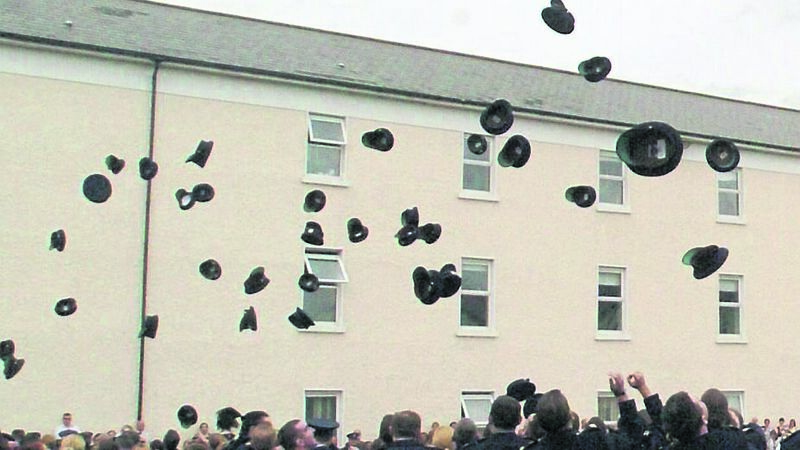Crime will flourish unless the thin blue line is strengthened

It related to a call by the TD and future Taoiseach Liam Cosgrave for a recruitment campaign to bring both the army and the gardaí up to adequate strength.
The article suggested that the call would find a sympathetic echo in the minds of a great many people, and there was a general feeling of unease among the public that all was not well within the ranks of the gardaí.
It lamented the alarming increase in lawlessness and the apparent inability of the gardaí to combat it, and said the public had every reason to feel frightened at the startling increase in crimes of violence.
Even petty crime, the editorial said, was on the increase. Homes were being attacked, the elderly were being assaulted. People were becoming more and more uneasy, and even alarmed for their safety, not to mention the safety of their property.
Governmental decisions not so many years ago to close down suburban garda stations, to dispense with the men on the beat, and substitute patrol cars, never found favour with the public, opined the Examiner in 1971, “and the mounting toll of depredation, which is now becoming commonplace, seems to justify the public criticism at the time”.
Just to remind you again, that piece was written half a century ago. It seems that little was learned since then.
A few short years ago, more rural garda stations were closed and we know now how that worked out.
The lack of a visible garda presence these days is a complaint that is echoed regularly across the country from both rural and urban communities.
That 1971 editorial further suggested that crime prevention was better than crime detection, but such prevention could never be effectively achieved as long as there was a shortage of manpower.
A serious focus was placed on community engagement, with an emphasis on making communities safer through public participation in crime prevention initiatives supported by community safety teams.
It paid dividends until the late noughties, when manpower shortages became an issue and community safety teams were deployed elsewhere, which brought about the demise of that particular strategy.
Fifty-two years later, the same question was asked in a recent article in The Echo: “When will Cork see more gardaí?”
It came on the back of a story where the Cork Taxi Council told The Echo that attacks on taxi drivers were happening far too often, and many drivers were not reporting attacks, and called for additional patrols on the city’s streets as a deterrent.
Cllr Deirdre Forde also highlighted the issue in her final few weeks as Lord Mayor.
“People have got to feel safe no matter where it is in the city,” she said. “Businesses work too hard to keep the city centre alive. More guards would give reassurance to the public.”
Carrigaline is another example of an area where representatives are blue in the face saying that a bigger garda presence is needed.
In 1971, the main reason for the reduction of gardaí was said to be lack of finance. Speaking in Cork recently, Garda Commissioner Drew Harris said that the constraints currently affecting numbers within An Garda Síochána did not relate to money, but were affected by the recruitment process.
Commissioner Harris stressed that he was committed to recruiting more officers, which was good to hear. But, for everyone concerned about safety on our streets, the question that remains is, when will they be seen?
Last April, the then acting Justice Minister Simon Harris said: “A key priority will be to continue to support An Garda Síochána in protecting our communities from crime through increased resources and a stronger and more diverse Garda service.
“We will invest in recruitment, training, and technology, and progress new legislation to help An Garda Síochána as they do their vital job protecting us.”
I imagine the Garda Representative Association (GRA) was pleased to hear that. They had previously stated they needed better conditions, training, equipment and protection, and also a better work-life balance, with clearer work patterns and a safer working environment, in order to recruit new gardaí and retain the members they already had.
To that end, a new maximum sentence for assaulting gardaí as well as new powers for officers to implement anti-social behaviour orders are among the goals for the Department of Justice for 2023.
That plan could see new powers given to gardaí to enforce anti-social behaviour orders and an increased maximum sentence for assaulting a peace officer of up to 12 years.
According to the GRA, independent research revealed that just 27% of the public regarded a career in An Garda Síochána as an attractive one for themselves or a member of their family; a fact that must be concerning for both the Garda Commissioner and the Minister for Justice.
It shouldn’t come as much of a surprise though. There is little respect for the garda uniform these days and patrolling the streets is more dangerous than ever.
Prosecuting gardaí doesn’t send out a positive message either, so what do they expect?







 App?
App?




